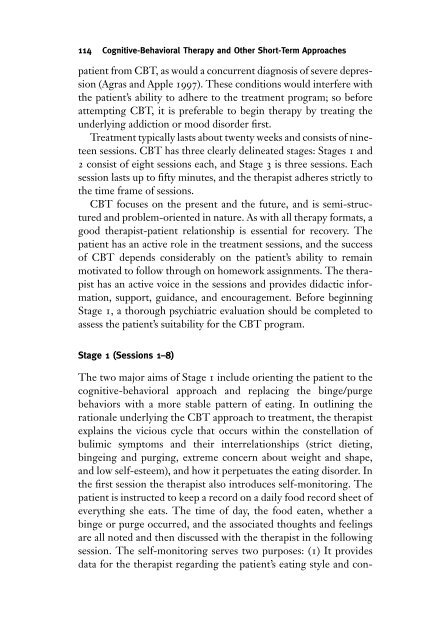Eating Disorders - fieldi
Eating Disorders - fieldi
Eating Disorders - fieldi
Create successful ePaper yourself
Turn your PDF publications into a flip-book with our unique Google optimized e-Paper software.
114 Cognitive-Behavioral Therapy and Other Short-Term Approaches<br />
patient from CBT, as would a concurrent diagnosis of severe depression<br />
(Agras and Apple 1997). These conditions would interfere with<br />
the patient’s ability to adhere to the treatment program; so before<br />
attempting CBT, it is preferable to begin therapy by treating the<br />
underlying addiction or mood disorder first.<br />
Treatment typically lasts about twenty weeks and consists of nineteen<br />
sessions. CBT has three clearly delineated stages: Stages 1 and<br />
2 consist of eight sessions each, and Stage 3 is three sessions. Each<br />
session lasts up to fifty minutes, and the therapist adheres strictly to<br />
the time frame of sessions.<br />
CBT focuses on the present and the future, and is semi-structured<br />
and problem-oriented in nature. As with all therapy formats, a<br />
good therapist-patient relationship is essential for recovery. The<br />
patient has an active role in the treatment sessions, and the success<br />
of CBT depends considerably on the patient’s ability to remain<br />
motivated to follow through on homework assignments. The therapist<br />
has an active voice in the sessions and provides didactic information,<br />
support, guidance, and encouragement. Before beginning<br />
Stage 1, a thorough psychiatric evaluation should be completed to<br />
assess the patient’s suitability for the CBT program.<br />
Stage 1 (Sessions 1–8)<br />
The two major aims of Stage 1 include orienting the patient to the<br />
cognitive-behavioral approach and replacing the binge/purge<br />
behaviors with a more stable pattern of eating. In outlining the<br />
rationale underlying the CBT approach to treatment, the therapist<br />
explains the vicious cycle that occurs within the constellation of<br />
bulimic symptoms and their interrelationships (strict dieting,<br />
bingeing and purging, extreme concern about weight and shape,<br />
and low self-esteem), and how it perpetuates the eating disorder. In<br />
the first session the therapist also introduces self-monitoring. The<br />
patient is instructed to keep a record on a daily food record sheet of<br />
everything she eats. The time of day, the food eaten, whether a<br />
binge or purge occurred, and the associated thoughts and feelings<br />
are all noted and then discussed with the therapist in the following<br />
session. The self-monitoring serves two purposes: (1) It provides<br />
data for the therapist regarding the patient’s eating style and con-









